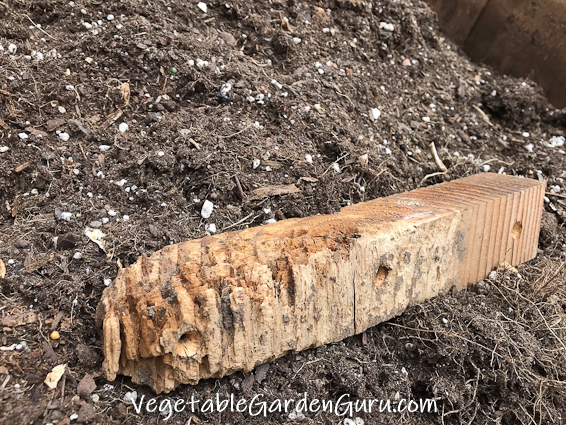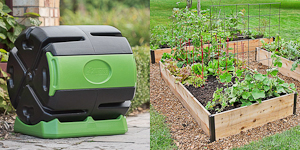- Home
- Raised Bed Vegetable Gardening
- Hugelkulture
Hugelkulture
is not a fermented food...
Hugelkulture is currently heavily trending in permaculture circles and is all over YouTube and Pinterest, but it's not a new idea. If you go back far enough, it takes you to Rudolph Steiner, of Waldorf Education and Biodynamics fame (1924). And it no doubt goes back even farther than that.
A hugelkulture bed is claimed to retain water and thus reduce external water requirements, as well as reduce fertilizer inputs. It sequesters carbon, and increases the levels of helpful mycorrhizal fungi in the soil. Some claim it "lengthens the growing season" because the decay process produces heat from below. I believe it can do all these things, but with a few caveats that are not so well publicized.
How to Make a Hugelkulture Bed
Here's what a hugelkulture bed is:
- A trench, usually about 3 feet wide by 6 feet long, dug out about 12-18" deep.
- A bunch of bucked logs/firewood chunks laid out in the trench, either sideways or lengthwise
- A bunch of smaller branches set in and around the larger logs
- A bunch of twigs set in the spaces still left
- A whole lotta compost/green grass clippings/fresh or old manure/veggie scraps/other compostables
- Water
- All the topsoil you dug out put back on the top
- Straw for a top mulch
- Whatever veggies you want to plant on the top
Upsides and Downsides
No Dig
 Fungi Cannot Distinguish Between Firewood and Your Raised Bed Wood, They Will Consume Them Both with Relish (and a Side of Mustard?)
Fungi Cannot Distinguish Between Firewood and Your Raised Bed Wood, They Will Consume Them Both with Relish (and a Side of Mustard?)One blogger I know says she filled all thirteen of her 3' high
wood-framed raised beds with hugelkulture on the bottom because she
"hates to dig". I guess that's one advantage.
If you don't dig the trench at the bottom. And if you don't mind hauling, lifting and setting all that firewood.
That
same blogger will discover down the road a ways that the fungi will
digest her wooden raised beds with the same gusto as all that firewood.
Water Retention
It's true that wood is more resistant to drying out than soil, because of the pore spaces, and also the wonderful fact that as fungi start to take over the decay process, they actually push some of the water that they take up out in front of them, softening the "food" (wood) so that they can more easily penetrate and digest it.
If you live where it rains enough, you will probably be able to decrease your watering, but if you live where it is very dry, you'll still need to water, though maybe less often. Once wood does dry out, it takes a lot of water to recharge it, so monitor your soil moisture levels carefully if you're hugelkulturing in the high plains or desert.
Fertilizer
It's also true that there are a few nutrients in wood, that will become available to the plant roots after the fungi have digested it. When is that? It will start releasing nutrients after about a year, but it can take up to twenty years to release all the nutrients back into the soil.
It all depends how consistently wet and warm it is where you live, as how well you have incorporated a nitrogen component on top of and around all the wood.
Organic matter decays through both bacterial and fungal processes. It all goes faster if both are present, so along with your high-carbon wood you need a goodly amount of higher-nitrogen green or manure waste to feed the bacteria.
Wood by itself does have some nutrients, but it is not a balanced, complete fertilizer.
One good thing, however, that is rarely mentioned, is that fungi are masters of reaching far and wide for mineral-based nutrients from the rock fraction of soil. They can extract nutrients from silt, sand and rock by excreting acids. Then they can move those nutrients along their mycelial filaments to feed plant roots in exchange for sugars.
I think some of the purported benefits of "wood makes great fertilizer" come not from the wood, but from the mycorrhizal fungi that spread far and wide while anchored in a wood food source.
It also depends on what surrounds your hugelkulture bed. Is it rich land currently growing mixed species grasses and forbes? Is it a vacant lot in the middle of a city lot with denuded soil? A hugelkulture is not an island.
Carbon Sequestration
Some carbon is lost as carbon dioxide as wood decays, though much less than if that same wood had been burned as firewood.
Season Extension
I'm not so sure about this one. Fungal decay does not generate heat. Bacterial decay generates heat at certain stages of decay, so for this "season extension" purported benefit to occur, you need to have incorporated a lot of green stuff like grass clippings or fresh manure to the hugelkulture. This process is usually relatively fast, so I don't think it is likely to give a sustained boost to the temperature of your vegetables.
Conclusions
Mycorrhizal fungi are amazing, and I think that a hugelkulture bed, done right, may be a good way to use up a bunch of pruned deadwood without burning it by utilizing the power of fungi. Outside of that, I don't think a hugelkulture bed is worth the effort it takes to build and maintain it, especially if nutrition is one of your prime goals in growing your own food.
And I would never build one in a wood-framed raised bed.
Help share the skills and spread the joy
of organic, nutrient-dense vegetable gardening, and please...
~ Like us on Facebook ~
Thank you... and have fun in your garden!
Affiliate Disclaimer
This website contains affiliate links to a few quality products I can genuinely recommend. I am here to serve you, not to sell you, and I do not write reviews for income or recommend anything I would not use myself. If you make a purchase using an affiliate link here, I may earn a commission but this will not affect your price. My participation in these programs allows me to earn money that helps support this site. If you have comments, questions or concerns about the affiliate or advertising programs, please Contact Me.Contact Us Page



